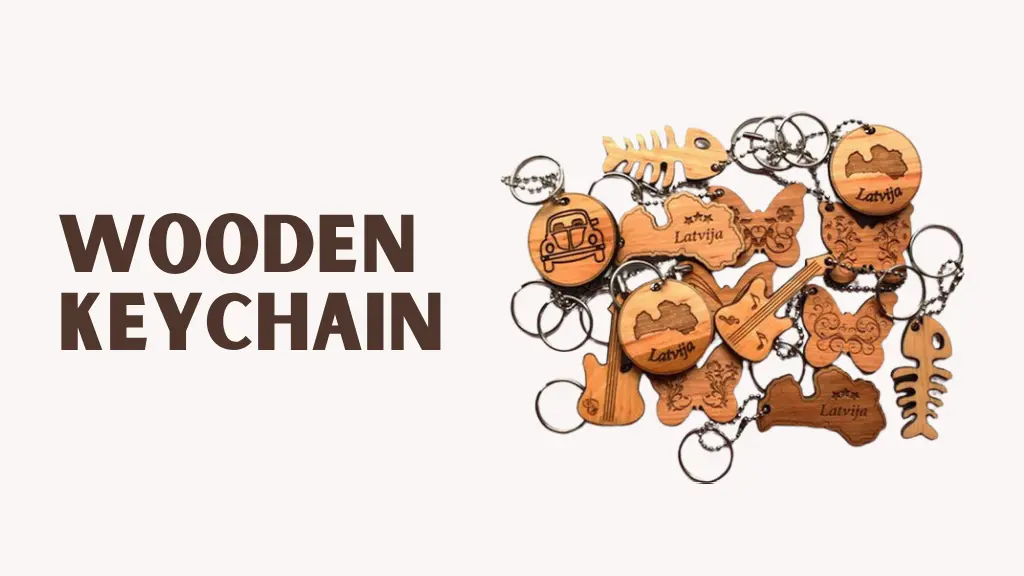A wooden keychain is more than just a way to organize keys. It represents the perfect mix of practicality, craftsmanship, and creativity. For woodworking enthusiasts, making one provides an enjoyable project that is budget-friendly, customizable, and accessible even for beginners. For buyers, it becomes an eco-conscious accessory that is stylish, durable, and often holds sentimental meaning when given as a gift or keepsake.
This guide walks you through everything needed to bring such projects to life. You will learn how to select the right type of wood, gather the proper tools, and follow the step-by-step crafting process. It also covers customization methods, important safety practices, and tips for successfully selling handcrafted designs. By the end, you’ll see how a small piece of wood can be transformed into a lasting, artistic item that is both functional and meaningful.
Why Wood Keychains Are Popular
Wooden keychains have stayed in demand because they combine practicality with creativity. Unlike plastic or metal options, wood provides a natural warmth and unique texture that resonates with people who appreciate craftsmanship and sustainability. They are functional yet deeply personal, easily shaped, engraved, painted, or stained to reflect individuality. This makes them a favorite choice for personalized gifts and keepsakes that carry sentimental value.
From an environmental standpoint, wood is renewable and biodegradable, giving it an edge over mass-produced plastic accessories. For hobbyists, these projects are approachable since they require minimal materials and tools. Beginners find them a great way to practice woodworking skills, while small businesses see them as versatile products. Whether marketed as handmade gifts, corporate promotional items, or eco-friendly accessories, they fit into multiple niches with strong appeal.
Choosing the Right Wood for a Keychain
The type of wood chosen has a direct impact on both quality and appearance. Hardwoods such as maple, oak, walnut, and cherry are often preferred because they provide strength along with attractive grain patterns. These woods are dense enough to resist scratches and dents, yet they can still be shaped, carved, and polished to achieve a refined finish. Softer options like cedar or pine are easier to work with but may not endure the same level of daily use.
Some artisans explore exotic varieties such as rosewood, zebrawood, or padauk to create pieces with bold colors and unique grains. While these options add striking visual appeal, they can be more expensive and sometimes raise sustainability concerns. Weight is another factor to consider; a lightweight keychain is comfortable to carry, while heavier woods may feel bulky in the pocket.
In practical use, maple is a common choice thanks to its balance of durability and subtle color, while walnut is favored for its rich, darker tones. For those mindful of sustainability, sourcing local woods is an effective approach since it reduces both cost and environmental impact. This thoughtful selection ensures that each handcrafted piece is not only beautiful but also long-lasting.
Essential Tools and Materials
Making a keychain does not require a full workshop, but having the right tools ensures better results. The most important material is the wood blank, which can be a small cut of hardwood or softwood. A lathe machine is commonly used to shape the piece, but hand tools such as carving knives and chisels can work as well.
To achieve a polished finish, sandpaper of various grits is needed, typically ranging from 120 to 400. A drill is essential for creating the hole where the eyelet screw or key ring will attach. For hardware, small eyelet screws and metal key rings are inexpensive and widely available.
The finishing stage requires oils, wax, or varnish. Oils bring out the natural grain, wax adds smoothness, and varnish provides protection against moisture and scratches. Optional tools include a laser engraver for detailed customization or a pyrography pen for wood burning designs. These tools are not essential but can significantly expand creative options.
Step by Step Guide to Making a Wooden Keychain
Creating a small wooden keychain begins with preparing the blank. Cut a piece of wood around one by two inches in size, then mark the center for drilling or for mounting on a lathe. A well-prepared blank ensures that shaping will be smoother and much safer. From there, shaping comes next. On a lathe, steady passes with sharp tools help form round, oval, or custom contours, while hand carving allows for unique forms and personal touches. This is the stage where creativity plays the largest role, as the overall style and feel of the piece are determined.
Once the form is complete, a hole must be drilled at the top for attaching hardware. Using a drill press or handheld drill works equally well, provided the wood is clamped securely to prevent slips. After drilling, the sanding process begins. Coarse sandpaper removes rough edges, while finer grits refine the texture, leaving the surface smooth and ready for finishing. This step is vital, as it not only enhances comfort in handling but also prepares the piece for protective coatings.
Finishing and assembly give the project its final touch. Oils highlight the natural color and grain, wax adds a soft sheen, and varnish creates a glossy, durable layer. Each option offers a different look and level of protection. Once the finish dries completely, the eyelet screw can be added to secure the key ring. At this point, the handmade keychain is complete, a blend of practicality, craftsmanship, and aesthetic appeal.
Creative Ideas
One of the most attractive qualities of wood is how versatile it is for personalization. Small accessories can be customized in endless ways, from engraving initials and names to shaping them into hearts, animals, or geometric designs. These options make them thoughtful gifts while also appealing to artistic tastes. Companies often take advantage of this flexibility by adding logos, turning a simple item into a promotional product that highlights both sustainability and creativity.
More advanced methods open up even greater possibilities. Artisans may layer different types of wood to create striking contrasts or use resin inlays for a modern, colorful effect. Others carve intricate miniature designs or combine wood with materials like leather and metal for extra character. With these techniques, what begins as a basic craft project can be transformed into a functional keepsake, a piece of art, or a powerful branding tool.
Customization Techniques
Adding customization increases the personal value of wooden accessories. Laser engraving is one of the most precise methods, allowing intricate designs such as names, logos, or meaningful symbols to be etched with clarity and detail. Pyrography, or wood burning, takes a more traditional approach by using heated tools to create rustic patterns and textures that emphasize the handmade character of each piece.
Other creative options include painting, staining, or applying resin finishes. Stains bring out the natural grain, paints add bold color, and resin coatings enhance durability while giving a glossy, contemporary look. Each technique requires practice, but part of the beauty lies in the slight imperfections that highlight craftsmanship. The chosen method ultimately depends on whether you want a natural, rustic, modern, or refined appearance.
Safety Precautions When Making Keychains
Although making a wooden keychain is a small project, safety should never be overlooked. Always wear safety glasses to protect against flying dust and chips. A dust mask is equally important because sanding produces fine particles that can be harmful when inhaled.
When drilling holes, secure the piece with clamps to prevent slipping, which could lead to injury. Keeping tools sharp reduces the risk of accidents, since dull tools are more likely to slip. If children will use the keychain, it is best to avoid toxic finishes and choose natural oils or food-safe waxes. Responsible safety practices ensure that the project remains enjoyable and hazard-free.
Turning Keychains Into a Business
A handcrafted accessory project can easily become the foundation of a small business. Many artisans start by selling to friends and family before moving on to online platforms. Etsy and Amazon Handmade are two of the most popular marketplaces for selling unique wooden designs. Local craft fairs also provide opportunities to interact directly with customers and receive immediate feedback. Social media platforms like Instagram and Facebook allow artisans to showcase creations and attract a following.
To succeed in this niche, it helps to focus on specific markets. Wedding favors, personalized pieces, and eco-friendly accessories are three examples of profitable niches. Offering bulk discounts for corporate events or custom branding services can also increase sales. Marketing should emphasize sustainability, craftsmanship, and personalization, which are strong selling points for today’s consumers.
Real-World Example of Success
One small business in Oregon began by making wooden key chains as wedding favors. Their handcrafted approach, paired with personalized engraving, quickly captured attention from customers who appreciated the combination of artistry and function. Word of mouth spread, and soon the business was receiving requests from eco-conscious buyers who valued sustainable gifts.
Within a year, their keychains attracted custom orders from companies seeking environmentally friendly promotional items. As the business expanded its product range, the keychain remained its signature product, symbolizing quality and authenticity. Today, the shop sells more than one thousand units each month and maintains an impressive 4.9-star rating from over five hundred reviews on Etsy, proving how a simple idea can grow into a thriving enterprise.
Conclusion
The wooden keychain may be a small project, but it delivers meaningful rewards. It is practical, affordable, and highly customizable, making it an excellent choice for beginners who want to practice woodworking techniques without needing extensive tools or materials. For gift-givers, it serves as a personalized and thoughtful option, while for entrepreneurs, it provides an accessible entry point into a craft-based business with strong potential.
By choosing the right type of wood, practicing safe techniques, exploring creative customization, and tailoring designs to customer preferences, artisans can create accessories that are both functional and memorable. This combination of craftsmanship, sustainability, and personal expression ensures that the keychain continues to stand as a timeless accessory with lasting appeal.
Frequently Asked Questions
What is the best wood for a keychain?
The best choices are hardwoods such as maple, oak, and walnut because they are durable and attractive. They resist scratches and dents while providing a polished finish.
Can a wood keychain be made without a lathe?
Yes. While a lathe makes shaping easier, hand tools such as carving knives, chisels, or a scroll saw can also be used to create unique designs.
How do I personalize a keychain?
Personalization can be done through engraving, pyrography, painting, or resin inlays. These methods allow you to add names, symbols, or decorative elements.
Are keychains durable for everyday use?
Yes. With the right wood and a protective finish, a wood keychain is strong enough for daily handling. Regular care will extend its lifespan.
Are wood keychains eco-friendly gifts?
They are an excellent choice for eco-conscious consumers. Made from renewable materials, they are biodegradable and sustainable compared to plastic alternatives.




